 Picket boats lined up at the Hinckley yard in Southwest Harbor. Image courtesy Ballard Collection, Southwest Harbor Public Library Digital Archive
Picket boats lined up at the Hinckley yard in Southwest Harbor. Image courtesy Ballard Collection, Southwest Harbor Public Library Digital Archive
USCG Picket Boats:
Hinckley’s first government contract was for 20 38' WWII Cabin picket boats for the U.S. Coast Guard; over the next two years he received contracts to build an additional 73. The design, which was based on New Jersey’s historic Sea Bright skiffs, was standardized by the U.S. Coast Guard, and about 540 were built between 1932 and 1943 by various yards along the East Coast. Originally launched and retrieved between beach and breaking surf, Sea Bright skiffs could be rowed or sailed. When engines became common in small craft, it was found that the flat bottom plank keel and square transom of the skiff design made a good planing hull that could slide onto beaches, although it also offered a rough ride offshore. The hollow “box keel” allowed engine installation to be horizontal, promoting a low center of gravity with no power lost due to the down-angle in the drive train.
 93 Picket boats were constructed for the U.S. Coast Guard.Image courtesy Ballard Collection, Southwest Harbor Public Library Digital Archive
93 Picket boats were constructed for the U.S. Coast Guard.Image courtesy Ballard Collection, Southwest Harbor Public Library Digital Archive
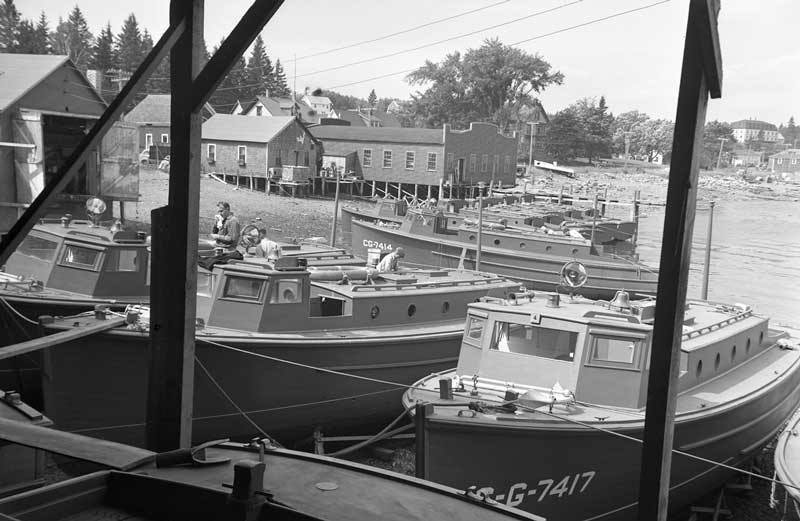 A group of 38-foot Picket boats under construction at the Hinckley yard. The boatbuilding company employed more than 300 people building boats for the U.S. government during the war. Image courtesy Ballard Collection, Southwest Harbor Public Library Digital Archive
A group of 38-foot Picket boats under construction at the Hinckley yard. The boatbuilding company employed more than 300 people building boats for the U.S. government during the war. Image courtesy Ballard Collection, Southwest Harbor Public Library Digital Archive
The 38' picket boat had a displacement of 15,700 pounds, a beam of 10.33', a draft of 3', a fuel capacity of 240 gallons, and a range of 175 miles. Power came from 6-cylinder Hall Scott, Sterling, or Murray engines, or from 225-hp Kermath engines; top speed was 20-25 knots. Some picket boats during the war were armed with small 25-lb. depth charges and Marlin machine guns. They were also assigned anti-submarine missions, anti-submarine net checks, frogmen patrols, crash boat work, and sunken ship rescue work.
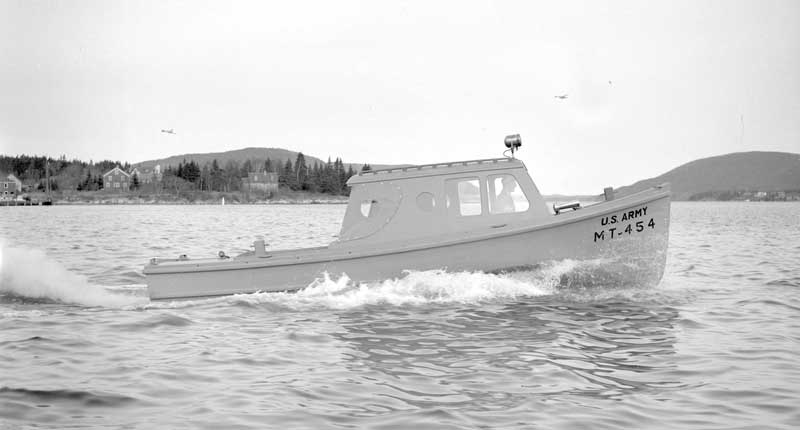 MT class boats (short for motor tow yawls) like this one were used to ferry cargo from ships to shore. Image courtesy Ballard Collection, Southwest Harbor Public Library Digital Archive
MT class boats (short for motor tow yawls) like this one were used to ferry cargo from ships to shore. Image courtesy Ballard Collection, Southwest Harbor Public Library Digital Archive
US Army MT and MTL Class Marine Tractors:
The U.S. Army placed orders with 41 civilian yards on both coasts and the Great Lakes to build 1,251 wooden MT and MTL Class marine tractors during the war. The MT Class Motor Towboats, also called Motor Tow Yawls or Sea Mules, were either 26' or 36' LOA. The Hinckley company built 253 of the 26' MT Class and an additional 64 motor mine yawls that used the same hull design. These MT and MTL harbor boats have not been widely recognized in lists of watercraft used in WWII, but photographs of the Hinckley company’s substantial effort in producing the 26' MT tugs and 46 of the 46' MTL tugs for the war effort between early 1941 and the end of 1944 are archived at the Southwest Harbor Public Library.
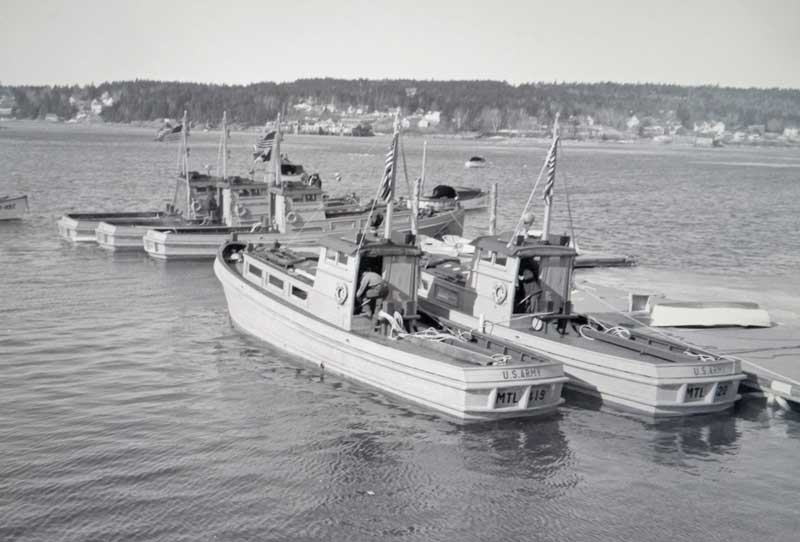 Five single-cabin marine tractor class tugs, which were also sometimes called sea mules, being fitted out in Southwest Harbor. Image courtesy Ballard Collection, Southwest Harbor Public Library Digital Archive
Five single-cabin marine tractor class tugs, which were also sometimes called sea mules, being fitted out in Southwest Harbor. Image courtesy Ballard Collection, Southwest Harbor Public Library Digital Archive
According to a 1944 U.S. Army field manual, the marine tractors were used to ferry cargo to shore from freighters and transports arriving in theaters of operation. “Cargo from the ships is loaded by Transportation Corps port company personnel onto barges. Then tugs, tow boats, or marine tractors propelled the barges to the shore for unloading. Any cargo too heavy for the vessel’s gear to lift is handled by a 60-ton floating crane,” according to the manual.
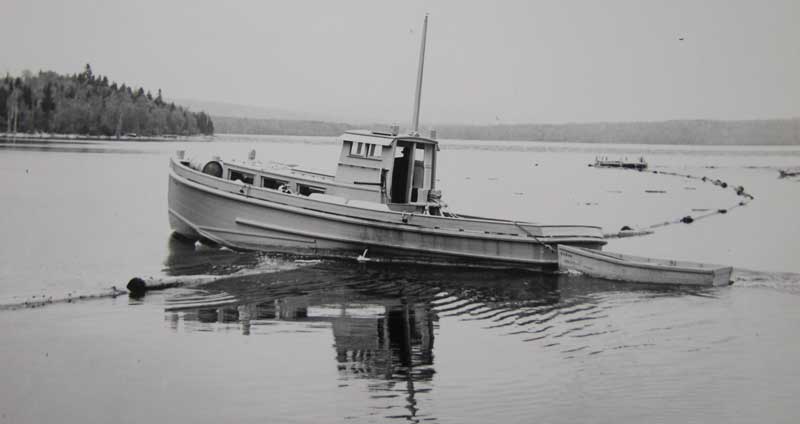 After the war, many of the tugs built by Hinckley were sold, including this one, which became a Great Northern Paper Co. logging towboat. Image courtesy Raymond H. Fogler Library Special Collections Department, University of Maine, Orono, Maine
After the war, many of the tugs built by Hinckley were sold, including this one, which became a Great Northern Paper Co. logging towboat. Image courtesy Raymond H. Fogler Library Special Collections Department, University of Maine, Orono, Maine
Hinckley also built 42 of the 46/47' MTLs. These had a displacement of 10,000 lbs., a beam of 12', a draft of 30", and a fuel capacity of 240 gallons. A 180 hp Consolidated Speedway MR-6 six-cylinder gasoline engine, or similar powerplant, provided power. Many of these tugs were used in China to tow river barges.
The only other Maine yard known to have built the MTL Class was the Stonington Yacht Basin which constructed 19 of them. The Stonington yard later became what is now Billings Diesel & Marine, Inc.
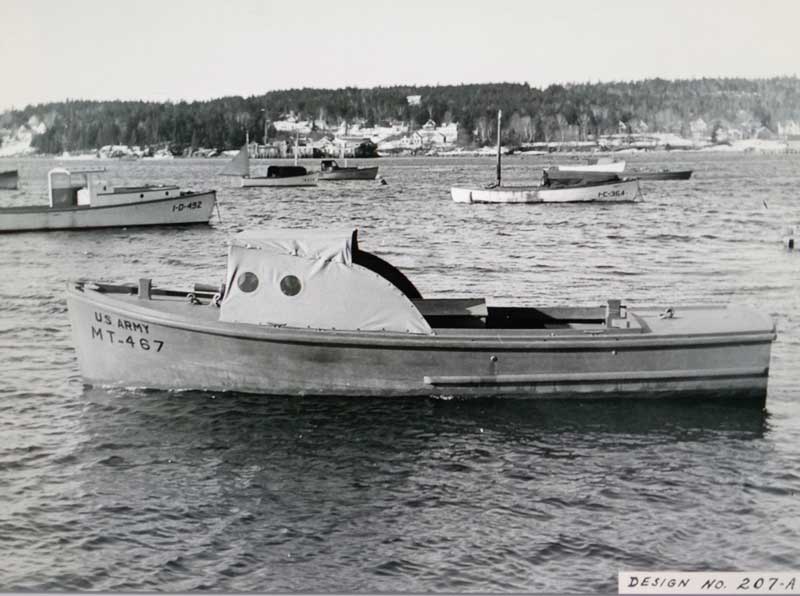 MT Class tugs were built with varying configurations on a common hull. The designs were reportedly based on the historic Sea Bright Skiff hull form developed on the northern shore of New Jersey in the early 19th century. Image courtesy Ballard Collection, Southwest Harbor Public Library Digital ArchiveAt the end of the war, many of these tugs were sold for use in the private sector on both the east and west coasts. One MTL tug became a Great Northern Paper Company logging towboat and boom jumper on the 13-mile long Seboomook Lake section of the West Branch of the Penobscot River in the post-war era, and likely served there until about 1955 when steel-hulled boom jumpers came into use.
MT Class tugs were built with varying configurations on a common hull. The designs were reportedly based on the historic Sea Bright Skiff hull form developed on the northern shore of New Jersey in the early 19th century. Image courtesy Ballard Collection, Southwest Harbor Public Library Digital ArchiveAt the end of the war, many of these tugs were sold for use in the private sector on both the east and west coasts. One MTL tug became a Great Northern Paper Company logging towboat and boom jumper on the 13-mile long Seboomook Lake section of the West Branch of the Penobscot River in the post-war era, and likely served there until about 1955 when steel-hulled boom jumpers came into use.
Roger Moody is a retired Maine municipal manager and county commissioner who writes about boats and boating history.






